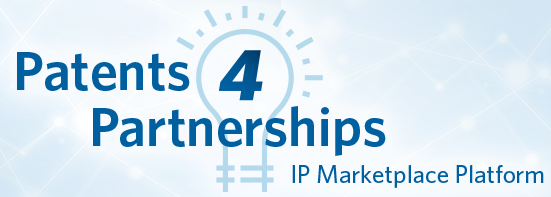“The USPTO’s expanded P4P platform would offer many benefits. While it may be too simple for the largest, most sophisticated players, it is attractive for those who desire another channel through which to monetize their underutilized IP assets.”
 Intellectual property (IP) is a “bridge to collaboration” between companies, and not just a “weapon of competitive warfare.” The U.S. Patent and Trademark Office (USPTO) launched an IP licensing marketplace, “Patents 4 Partnerships” (P4P), on May 4 that is a platform furthering this ideology. The P4P platform is initially being limited to technologies related to COVID-19 to address the ongoing pandemic. However, USPTO Director Andrei Iancu seems prepared to expand the platform to include other technologies, including artificial intelligence (AI) innovations and cancer treatments, based on interest and engagement during this pilot phase. Director Iancu’s leadership in validating an open patent marketplace concept and playing an active role in its evolution is promising. Assuming this evolution comes to fruition, the P4P platform will provide company executives, university technology transfer offices (TTOs), research institutions, and inventors/startups that have limited resources a valuable tool to match their technologies with interested buyers and licensees.
Intellectual property (IP) is a “bridge to collaboration” between companies, and not just a “weapon of competitive warfare.” The U.S. Patent and Trademark Office (USPTO) launched an IP licensing marketplace, “Patents 4 Partnerships” (P4P), on May 4 that is a platform furthering this ideology. The P4P platform is initially being limited to technologies related to COVID-19 to address the ongoing pandemic. However, USPTO Director Andrei Iancu seems prepared to expand the platform to include other technologies, including artificial intelligence (AI) innovations and cancer treatments, based on interest and engagement during this pilot phase. Director Iancu’s leadership in validating an open patent marketplace concept and playing an active role in its evolution is promising. Assuming this evolution comes to fruition, the P4P platform will provide company executives, university technology transfer offices (TTOs), research institutions, and inventors/startups that have limited resources a valuable tool to match their technologies with interested buyers and licensees.
The Future of the P4P Platform
The P4P platform is newsworthy because it includes pending, published U.S. patent applications and appears to be on a trajectory to achieve the critical mass needed to be successful. The P4P platform is not the first centralized, searchable repository of patents, nor is it the USPTO’s first attempt at assisting inventors with licensing. In fact, every second Tuesday of the month, the USPTO’s Official Gazette (OG) publication includes a listing of granted U.S. patents for license/sale. Anecdotally, in many recent months the OG has listed less than about 10 patents for license/sale, many of which are old patents. With so few listed patents and no pending patent applications, the OG is not generally regarded as a viable marketplace for licensing and monetization. In addition, the OG references the Federal Laboratory Consortium for Technology Transfer (FLC), which provides a searchable database of federal agency technologies available for licensing, but again not pending patent applications. And, only federal agencies’ patents are listed in the FLC database— absent an open platform for all to participate, generating enough momentum would be a challenge.
In just a couple of weeks, the P4P platform already boasts more than 180 U.S. patents and patent applications related to COVID-19 technologies. In contrast, several other patent marketplaces, such as the Danish Patent Office’s IP Marketplace that has been in operation for many years, have failed to reach a sufficient number of sellers and buyers needed to be sustainable. The Danish IP Marketplace does not appear to permit pending patent applications. Meanwhile, the World Intellectual Property Organization (WIPO) provides a searchable database of pending Patent Cooperation Treaty (PCT) patent applications in which filers have submitted a “Request for Indication of Availability for Licensing Purposes” form. However, even the WIPO database returns only about 520 U.S. hits when filtered by the “Licensing Availability” parameter; that does not seem sufficient for critical mass. The expectation is that the USPTO’s leadership and the attracted counterparties will generate enough momentum to make P4P sustainable.
University TTOs Among the Most to Benefit
Filing, prosecuting, and monetizing patents can be expensive. Many university TTOs have budget constraints that require only pursuing those patent applications that have a clear path to profitability. Reportedly, more than 95% of foreign patent rights are waived, less than 30% of provisional patent applications are converted into a full patent, and a large number of university research publications describe inventions that are not reported as invention disclosures (e.g., a 10-to-1 ratio between the number of publications and the number of invention disclosure submissions). Meanwhile, empirically, the average price per patent family purchased through the Industry Patent Purchase Program (IP3) in 2016 was approximately $96,000, and the median price was $100,000 across 1,378 deals submitted by 434 patent owners. The IP3, which is administered by Allied Security Trust (AST), is just one of several fixed-price, fixed-duration, collaborative patent buying programs that is not limited to any one technology area. Given the potential six-figure payment for a patent asset, TTOs might fund future budgets from these patent royalties and sales.
Notably, however, IP3 requires a granted patent and eliminates negotiations between the parties by permitting patent owner submissions only during a limited time window (e.g., two weeks a year) and with a pre-set, binding price at which they have agreed to sell. In contrast, the P4P platform offers a non-binding, open marketplace that encourages commercialization of technologies by connecting stakeholders in the early stages of the patenting process. Given that the P4P lists not only patents but pending patent applications, potential licensees can identify technologies of interest at an early stage and contribute to the cost of patent prosecution, foreign patent rights, and continuation patent filings, while also providing strategic input for patent claiming strategies. TTOs should consider requesting early publication to maximize their time on the P4P platform before patent prosecution costs arise (See 37 C.F.R. § 1.219).
Takeaways
The USPTO’s expanded P4P platform would offer many benefits. While it may be too simple for the largest, most sophisticated players, it is attractive for those who desire another channel through which to monetize their underutilized IP assets. Notably, the P4P platform allows potential licensees to find technologies of interest at an early stage and have a hand in their patenting. Additionally, with the USPTO at the helm, the P4P platform may likely attract a critical mass to evolve the platform into a bustling marketplace for facilitating IP transactions.

![[IPWatchdog Logo]](https://ipwatchdog.com/wp-content/themes/IPWatchdog%20-%202023/assets/images/temp/logo-small@2x.png)


![[Advertisement]](https://ipwatchdog.com/wp-content/uploads/2024/04/UnitedLex-May-2-2024-sidebar-700x500-1.jpg)
![[Advertisement]](https://ipwatchdog.com/wp-content/uploads/2024/04/Artificial-Intelligence-2024-REPLAY-sidebar-700x500-corrected.jpg)
![[Advertisement]](https://ipwatchdog.com/wp-content/uploads/2024/04/Patent-Litigation-Masters-2024-sidebar-700x500-1.jpg)

![[Advertisement]](https://ipwatchdog.com/wp-content/uploads/2021/12/WEBINAR-336-x-280-px.png)
![[Advertisement]](https://ipwatchdog.com/wp-content/uploads/2021/12/2021-Patent-Practice-on-Demand-recorded-Feb-2021-336-x-280.jpg)
![[Advertisement]](https://ipwatchdog.com/wp-content/uploads/2021/12/Ad-4-The-Invent-Patent-System™.png)






Join the Discussion
No comments yet.